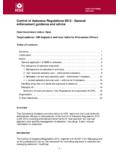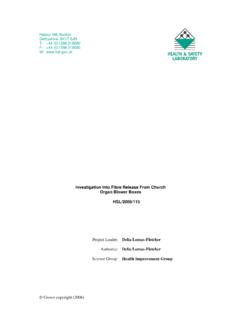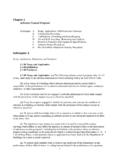Transcription of Chrysotile Asbestos PUBLIC HEALTH AND …
1 Asbestos a group of minerals that includes Chrysotile , crocidolite, amosite, anthophyllite, tremolite and actinolite is one of the most important occupational carcinogens. At least 107 000 people die each year from Asbestos -related diseases, including lung cancer. Even though the use of Asbestos has declined in many countries, Chrysotile is still widely used, particularly in developing countries. This publication on Chrysotile Asbestos is divided into three parts. The first part reproduces a WHO short information document for decision-makers on the elimination of Asbestos -related diseases.
2 The second part addresses questions commonly raised in policy dis-cussions, specifically to assist decision-makers. The third part is a technical summary of the HEALTH effects of Chrysotile , which brings together and summarizes for the first time the most recent author-itative WHO evaluations performed by its International Agency for Research on Cancer and its International Programme on Chemical Safety. The technical summary also reviews results from key studies published after those evaluations and the conclusions drawn from WHO assessments of publication will be of interest to all government officials who need to make informed decisions about management of the HEALTH risks associated with exposure to Chrysotile Asbestos .
3 Department of PUBLIC HEALTH , Environmental and Social Determinants of HEALTH (PHE)Family, Women s and Children s HEALTH (FWC)World HEALTH Organization (WHO)Avenue Appia 20 CH-1211 Geneva 27 : 978-92-4-156481-6 Chrysotile AsbestosPUBLIC HEALTH AND ENVIRONMENTC hrysotile AsbestosFurther information from WHO on chemicals of major PUBLIC HEALTH concern, including Asbestos , can be found at the following web address: AsbestosWHO Library Cataloguing-in-Publication Data: Chrysotile , Serpentine. Exposure. Exposure. prevention and control. HEALTH Organization. ISBN 978 92 4 156481 6 (NLM classification: WA 754) World HEALTH Organization 2014 All rights reserved.
4 Publications of the World HEALTH Organization are available on the WHO website ( ) or can be purchased from WHO Press, World HEALTH Organization, 20 Avenue Appia, 1211 Geneva 27, Switzerland (tel.: +41 22 791 3264; fax: +41 22 791 4857; e-mail: Requests for permission to reproduce or translate WHO publications whether for sale or for non- commercial distribution should be addressed to WHO Press through the WHO website ( ).The designations employed and the presentation of the material in this publication do not imply the expression of any opinion whatsoever on the part of the World HEALTH Organization concerning the legal status of any country, territory, city or area or of its authorities, or concerning the delimitation of its fron-tiers or boundaries.)
5 Dotted and dashed lines on maps represent approximate border lines for which there may not yet be full mention of specific companies or of certain manufacturers products does not imply that they are endorsed or recommended by the World HEALTH Organization in preference to others of a similar nature that are not mentioned. Errors and omissions excepted, the names of proprietary products are distin-guished by initial capital reasonable precautions have been taken by the World HEALTH Organization to verify the information contained in this publication. However, the published material is being distributed without warranty of any kind, either expressed or implied.
6 The responsibility for the interpretation and use of the material lies with the reader. In no event shall the World HEALTH Organization be liable for damages arising from its use. The production, translation and publication of this document were financially supported by the International Development Fund program of the Permanent Mission of Australia to the United Nations, the Government of Germany and the European Commission. The views expressed herein do not necessarily reflect the views of these credits: Cover page, pages iv, 8, 10, 14, 15, 17, 19, 20, 23, 29, 30, 32, 34, 35, 36, 37 WHO / R.
7 Moore; page 1 ; page 3 I. Masayuki; pages 4, 33 P. Madhavan; page 6 Geological Survey / A. Silver; pages 9, 11, 25 M. Darisman; pages 24, 27 S. Furuya; page 34 (bottom) Geological SurveyDesign: In s Communication Asbestos / iiiContentsForeword ..1 Elimination of Asbestos -related diseases ..2 Commonly raised questions and answers ..6 Additional Information ..12 Technical summary of WHO evaluations of Chrysotile ..13iv / Chrysotile ASBESTOSCHRYSOTILE Asbestos / 1 ForewordMany countries have already taken action at a national level to pro-hibit the use of all forms of Asbestos to limit exposure and so control, prevent and ultimately eliminate Asbestos -related diseases, from which at least 107 000 people die each year globally.
8 However, there are other countries that, for a range of reasons, have yet to act in the same manner. With that in mind, the prime intent of this publication is to assist Member States of the World HEALTH Organization (WHO) in mak-ing informed decisions about management of the HEALTH risks attached to exposure to Chrysotile document is divided into three parts. The first part reproduces a WHO short information document for decision-makers on the elimination of Asbestos -related dis-eases, updated in March 2014. The second part addresses questions commonly raised in policy discussions, specifically to assist decision-makers in coming to a view.
9 The third part is a technical summary of the HEALTH effects of Chrysotile , which brings together and summarizes for the first time the most recent authoritative WHO evaluations performed by its International Agency for Research on Cancer and its International Programme on Chemical Safety. The technical summary also reviews results from key studies published after those evaluations and then, briefly, the con-clusions drawn from WHO assessments of commend this publication to ministers, government officials and others who may wish or need to take decisions on, or provide advice related to, Asbestos and in par-ticular Chrysotile Asbestos and the HEALTH consequences of Maria NeiraDirector, Department of PUBLIC HEALTH , Environmental and Social Determinants of HealthWorld HEALTH Organization.
10 Geneva2 / Chrysotile ASBESTOSE limination of Asbestos -related diseasesUpdated March 2014 Asbestos is one of the most important occupational carcinogens, causing about half of the deaths from occupational cancer (1, 2). In 2003, the Thirteenth Session of the Joint International Labour Organization (ILO)/World HEALTH Organization (WHO) Committee on Occupational HEALTH recommended that special attention should be paid to the elimination of Asbestos -related diseases (3). World HEALTH Assembly (WHA) Resolution from 2005 on cancer prevention and control urged Member States to pay special attention to cancers for which avoidable exposure is a factor, particu-larly exposure to chemicals at the workplace and in the environment.















